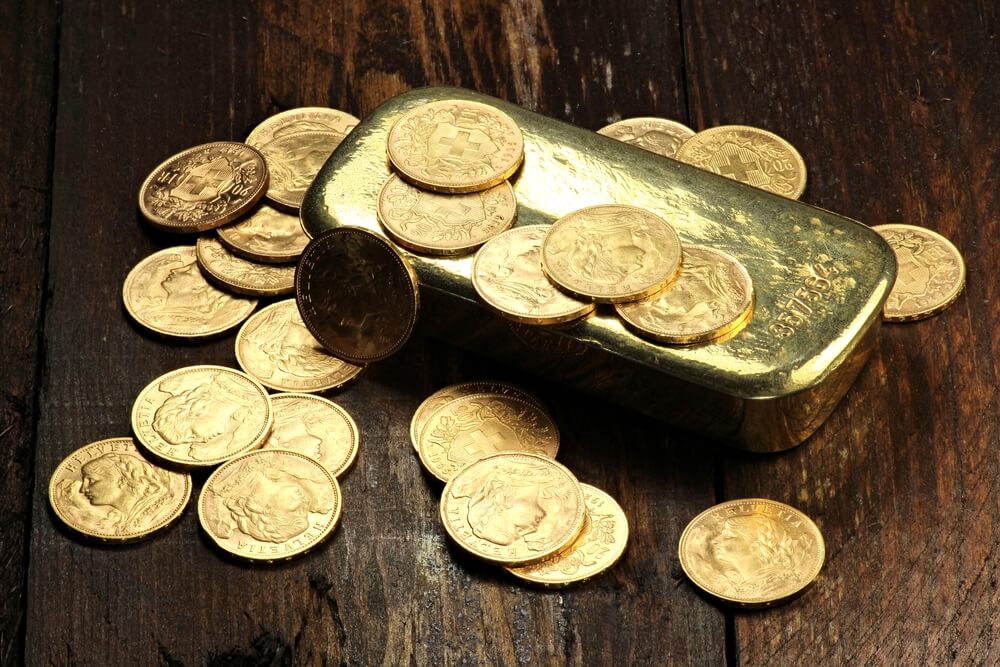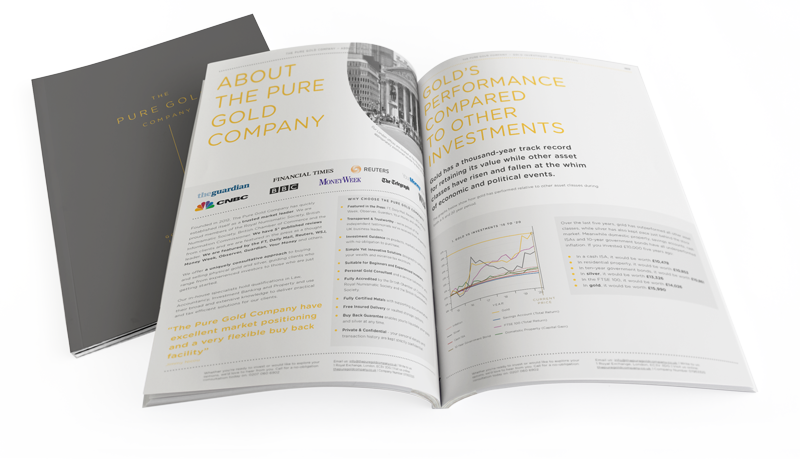Gold and gold miners are back in a downtrend. Occasionally, there are glimmers of hope, only for the sellers to come piling back in. The slide began shortly after the commodities spike in the spring following Vladimir Putin’s invasion of Ukraine, and it has been relentless. Your author shakes his head. Isn’t gold supposed to go up during times of war? Isn’t it the go-to asset in times of inflation? Apparently not.
However, if one views gold as simply another currency, then its performance has not been as bad as the headline numbers suggest. It has not done as well as the dollar, but it has outstripped the pound and the euro. Even though gold is quoted in US dollars, the dollar price of gold is irrelevant to us British investors. If you pay pounds to buy gold, and you will eventually sell for pounds, all that matters is the sterling price of gold.
The chart below shows gold in pounds over the past ten years. Gold cost £700-£800 an ounce (oz) in 2014 and 2015, and is now just shy of £1,475/oz. It is not far off its highs around £1,575/oz and remains in a clear long-term uptrend. In other words, gold has done its job and hedged investors against the mess that has been sterling these last five years.
Gold price in pounds
The ideal backdrop for gold
But, really, you want to see gold rising against all currencies. Panicking capital has been fleeing to the US dollar, which has been occupying the safe space that might normally belong to gold.
The US is tightening monetary policy faster than the UK, Japan or Europe and the prospect of higher yields on US assets has made the dollar more attractive. The US is ahead in the rate-rising cycle and until Japan, the UK and Europe start tightening as aggressively, the dollar is going to remain strong.
The ideal macroeconomic environment for gold is for equities to be weak and for government bond yields to be lower than expected inflation. At present we have the former, but not the latter. Longer-term inflation expectations are still below 3%. If they were at 8% or 10%, but rates were 5%, then capital would seek out the alternative that is gold. That is when so-called real (inflation-adjusted) interest rates are negative.
You want to be at a point where central banks are reluctant to raise rates and yet inflation won’t go away – in the US, at least, we do not have that. Yet. How permanent is this inflationary episode? How much will central banks raise rates? These are all questions we must answer if we are to make the decision to buy gold. Inflation might come down a little as weaker oil and metals prices filter through, but I think we’ll remember pre-Covid inflation numbers as halcyon.
Another issue to ponder is whether gold is an analogue asset struggling to adapt to a digital age. Gold is perhaps the oldest substance on earth. It was present in the dust which formed the solar system four-and-a-half billion years ago and its origins are thought to lie in supernovae and the collision of neutron stars. It came to earth via the asteroids that then bombarded the planet.
While highly malleable, it is also the most permanent substance, thought to be indestructible. All the gold that came to earth all those billions of years ago is still intact. You can batter it into a film just one atom thick but you cannot destroy gold. As a result, all the gold that has ever been mined, save that which has been dissolved in aqua regia, is thought to still exist, even if lost.
That’s why gold has been such good money. It lasts. Value today, however, is almost entirely digital. Money itself is digital: just 2%-3% of Western money exists as cash. The bond market is mostly digital. Software, intellectual property (IP), cryptocurrency – digital is where the value is. It’s also where most of Western growth has been these past 30 years.
Russia and China could develop a new global currency
Rapid recent geopolitical developments, however, suggest that gold is far from irrelevant. A new gold-backed currency could emerge. With Putin’s invasion of Ukraine, I was quite amazed by the speed at which the US weaponised the dollar and the banking system. Some $300bn in Russian central bank assets were confiscated (about one fifth of Russian annual GDP) and Russia was frozen out of SWIFT, the international payments system. Putin retaliated by demanding roubles for Russian gas. The currency wars well and truly began.
If Russia is not to be isolated internationally, it needs an international currency it can trade with. Just last month Putin said, “The issue of creating an international reserve currency based on a basket of currencies of our countries is being worked out.”
Sergey Glazyev, a former Kremlin adviser, now minister in charge of integration and macroeconomics of the Eurasia Economic Union (EAEU), is, it seems, supervising a new money system for the EAEU and China. “The world’s new monetary system, underpinned by a digital currency, will be backed by a basket of new foreign currencies and natural resources”.
“All interested countries will be able to join. The weight of each currency in the basket could be proportional to the GDP of each country, its share in international trade, as well as population and territory size. In addition, the basket could contain an index of prices of main exchange-traded commodities: gold and other precious metals, key industrial metals, hydrocarbons, grains, sugar, as well as water and other natural resources.”
Western nations may have shunned the “Russian Davos” in June – the St Petersburg International Economic Forum – but key representatives from China, India, Iran, Turkey and many Arab nations were there. The recurring theme was trade between non-Western powers in a US dollar-controlled world of sanctions and a new, non-Western international currency.
Meanwhile we have the The Shanghai Cooperation Organisation (SCO), which had its latest summit last week in Samarkand, Uzbekistan. In terms of geographical scope and population, it is the world’s largest regional organisation, covering 40% of the world population and over 30% of global GDP. Its members are China, Russia, India, Pakistan, Iran (which just joined), Kyrgyzstan, Tajikistan, Kazakhstan and Uzbekistan. And Turkey’s president Recep Tayyip Erdogan says he is considering membership. These are not exactly pro-Western nations.
Both Putin and Xi Jinping of China called for a reshaping of the international system. Various infrastructure projects being developed, notably a trans-Afghan railway to link Uzbekistan to Pakistan, a China-Central Asia natural gas pipeline and a China-Kazakhstan-Uzbekistan railway. China, which, as we know, is beholden to both Europe and the US for its exports, clearly wants to open up new markets.
Are these nations seriously going to want to trade in dollars? You can bet your bottom dollar that many of China and Eurasia’s brightest minds are plotting an alternative system. But it’s a lot easier said than done.
The problem of trust
To back a currency with commodities would raise all sorts of problems relating to storing raw materials. And if you use futures, you need to trust your trading partner. It is the same with systems based around government debt, GDP and fiat currencies, too.
The record of the regimes involved is hardly unblemished. The body language between the various leaders, especially China and Russia, does not suggest total trust. How then to make a money system that is practical and that everyone can trust?
The answer is an obvious shiny yellow material, analogue asset in a digital world or not. It is often bandied about that among China’s many ambitions is for the yuan to be the global reserve currency. But every international reserve currency in history started out backed by gold. Whether it was the pound, the dollar, the florin or the currencies of the ancient world, they were all at least as good as gold, if not gold itself.
They may have ended up debased into oblivion, but they started off backed by gold and sometimes some silver, too. It was only because the money was sound that it won global trust in the first place. Even John Maynard Keynes (who in 1924 declared the gold standard a barbarous relic) in 1942 proposed a supranational currency backed by gold: the bancor. Would such a system be practical today? I think so.
Who owns the gold makes the rules
We know that many countries in the SCO have plenty of gold and have been increasing their holdings. In the 14 years between 2006 and 2020, Russia’s central bank more than quintupled the country’s gold holdings, from around 400 tonnes to today’s 2,300 tonnes or so. It’s now world’s fifth-largest gold owner.
Then there is China. It has been quietly de-dollarising. Since 2021 China has lowered its holdings of both dollars and US Treasuries by 10%. Its holdings in US Treasuries have dropped by over $100bn since 2021, and it now has less than $1trn in US debt for the first time since 2010.
Its US dollar foreign-exchange reserves have come down from $3.25trn to $3trn over the same period. Having seen what happened to Russia, China will not want to be too vulnerable to a banking system that is run by the West.
Then there are China’s gold holdings. I consider this the most important story in world finance, yet it is largely ignored. China has far more gold than it says. China’s stated reserves are 1,948 tonnes of gold (barely 3% of its foreign exchange reserves). America’s are 8,100 tonnes (over 65% of national reserves).


